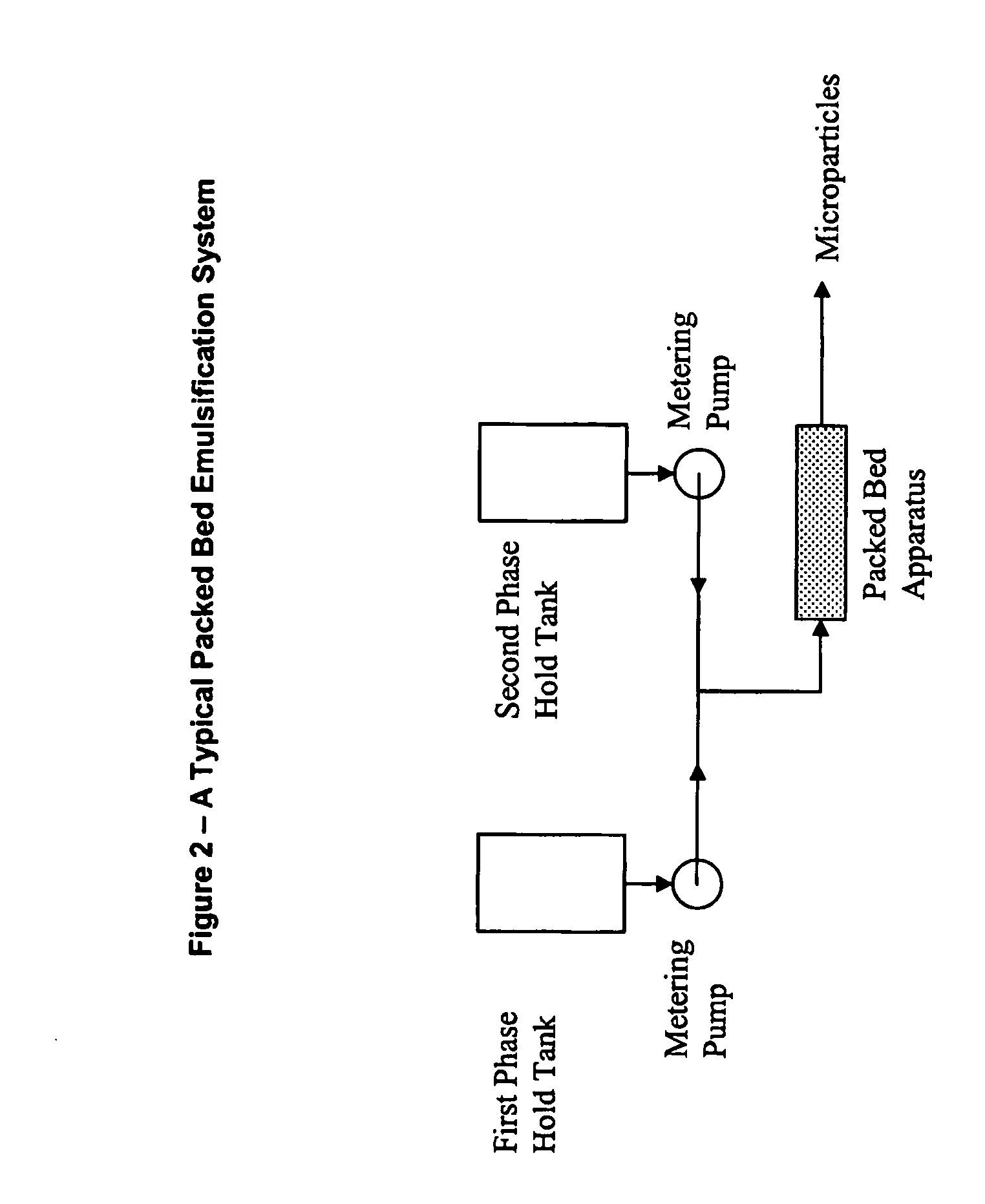Method for the production of emulsion-based micro particles
a technology of emulsion-based micro particles and emulsion, which is applied in the direction of powder delivery, flow mixer, granular delivery, etc., can solve the problems of inability to consistently produce a final product with the same properties, wide range of microparticle sizes, and inability to meet the requirements of the majority of microparticle products in batch to batch variation
- Summary
- Abstract
- Description
- Claims
- Application Information
AI Technical Summary
Benefits of technology
Problems solved by technology
Method used
Image
Examples
example 1
Preparation of Biodegradable Polymer Microspheres
[0073] A first phase containing 10% PLGA was prepared by dissolving 10 grams 85:15 PLGA (Medisorb 8515DLC01, Alkermes, Inc., 6960 Cornell Rd., Cincinnati, Ohio 45242) in 90 grams of ethyl acetate. The second phase was prepared by dissolving two grams of poly(vinyl-alcohol) (PVA) and 16 grams of ethyl acetate in 198 grams of water. Both solutions were placed inside separate temperature-controlled feed vessels at 20° C. (FIG. 2).
[0074] The second phase was pumped through a packed bed apparatus (6 mm Polytetrafluoroethylene (PTFE) tubing, 150 mm long, filled with 500μ glass beads) of the present invention at a rate of 1 ml / min. The first phase was pumped at the same time through the same packed bed apparatus at a flow rate of 1 ml / min. The emulsion was collected in an excess volume of water, the solvent was removed and the hardened microparticles separated.
[0075] The microspheres were analyzed by laser light scattering for size distri...
example 2
Preparation of 2-Methoxyestadiol (2ME) Microspheres
[0080] A first phase was prepared by dissolving 200 mg of 2ME and 400 mg of 50:50 PLGA in 7 ml of ethyl acetate. 2 grams of poly(vinyl-alcohol) (PVA) were dissolved in 198 grams of water to prepare the second phase. Both phases were then placed inside temperature-controlled water baths at 65° C.
[0081] The second phase was pumped through a packed bed apparatus (6 mm PTFE tubing, 150 mm long, filled with 500 p glass beads) of the present invention at a rate of 1.5 ml / min. The first phase was pumped at the same time through the same packed bed apparatus at a flow rate of 1 ml / min. The emulsion was collected inside a glass beaker where the solvent was removed from the emulsion droplets.
[0082] The hardened microspheres were centrifuged, and the microspheres were washed 3 times with water. The microspheres were analyzed for particle size distribution with the following results:
[0083] Mean Diameter=40 μm (volume statistics)
[0084] D10=...
example 3
Preparation of PEGylated Insulin Microspheres
[0087] A first phase was prepared by dissolving 213 mg of PEGylated insulin (U.S. Provisional Application No. 60 / 462,364 entitled “Method for Preparation of Site-Specific Protein Conjugates”) and 748 mg of 45:55 PLGA in 10 ml of methylene chloride. Next, 2 grams of poly(vinyl-alcohol) (PVA) were dissolved in 198 grams of water to prepare the second phase.
[0088] The first phase was pumped through a packed bed apparatus (6 mm PTFE tubing, 150 mm long, filled with 500μ glass beads) of the present invention at a rate of 1.7 ml / min. The second phase was pumped at the same time through the same packed bed apparatus at a flow rate of 0.7 ml / min. The emulsion was collected inside a glass beaker where the solvent was removed by evaporation.
[0089] The finished microspheres were filtered and washed with water, and then dried open to the atmosphere overnight. The dried microspheres were analyzed for particle size distribution with the following re...
PUM
| Property | Measurement | Unit |
|---|---|---|
| size | aaaaa | aaaaa |
| diameter | aaaaa | aaaaa |
| length | aaaaa | aaaaa |
Abstract
Description
Claims
Application Information
 Login to View More
Login to View More - R&D
- Intellectual Property
- Life Sciences
- Materials
- Tech Scout
- Unparalleled Data Quality
- Higher Quality Content
- 60% Fewer Hallucinations
Browse by: Latest US Patents, China's latest patents, Technical Efficacy Thesaurus, Application Domain, Technology Topic, Popular Technical Reports.
© 2025 PatSnap. All rights reserved.Legal|Privacy policy|Modern Slavery Act Transparency Statement|Sitemap|About US| Contact US: help@patsnap.com


